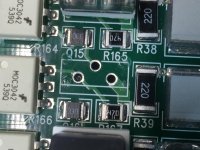highroadtoolco
Plastic
- Joined
- Dec 27, 2020
- Location
- Golden, Colorado
Hey Tony, Thanks for weighing in!
I have not found a detailed schematic for this board yet.
I've gotten started on some of your suggestions.
I didn't actually perform the continuity test yet because I think I would need to work up some much longer leads if I'm understanding your guidance. It seems like the tests below would confirm continuity though correct??
Here are some results from ohm testing:
Test direct from solenoid: .512
same test but from leads traced back to connector (P55) at I/O board: .512
Test at solenoid again but with all connectors intact: .515
I also did some cleaning with alcohol as suggested.
I am now going to attempt the voltage checks. Is the correct procedure for this to put one probe on a ground and then use the other to probe all the various component connections?
It's good to hear there might be a less expensive repair solution if we can track down a bad component. I'd certainly want to find someone with some experience.
Thanks again!
I have not found a detailed schematic for this board yet.
I've gotten started on some of your suggestions.
I didn't actually perform the continuity test yet because I think I would need to work up some much longer leads if I'm understanding your guidance. It seems like the tests below would confirm continuity though correct??
Here are some results from ohm testing:
Test direct from solenoid: .512
same test but from leads traced back to connector (P55) at I/O board: .512
Test at solenoid again but with all connectors intact: .515
I also did some cleaning with alcohol as suggested.
I am now going to attempt the voltage checks. Is the correct procedure for this to put one probe on a ground and then use the other to probe all the various component connections?
It's good to hear there might be a less expensive repair solution if we can track down a bad component. I'd certainly want to find someone with some experience.
Thanks again!
If you have 85 volts on the solenoid it looks like leakage.
Does anyone have actual schematic of the control?
If a solid state relay there could be an internal leaky component or there could be conductive crud someplace.
You need to trace back the cable from solenoid to board.
Confirm with ohm meter.
Do 2 checks, simple continuity from end to end then measure coil resistance with cable connected and not connected.
Measure again at circuit board, the resistance connected should be same and go open not connected.
You need t be certain you have correct cable.
Now if possible follow the trace to the active component, Google the number on it to identify it.
Locate other same items on the circuit board too.
Look for any crud, some denatured alcohol and a brush and rag can work miracles.
Return all to normal and apply power.
If you found the device on Google you can see control and voltage connections.
Measure voltage on each pin when both active and not.
Do same for another same device.
If the device is bad the control voltages will be similar to the other device but the output different.
If the drive to the device is bad the voltage will be different.
Digikey likely has the device.
If the Haas fix is new board and not exchange then changing device may be worth a shot.
There are places that can replace the component, look up two way radio dealers and many have old folks like me who did component level and have the proper tools to replace if you bring the parts.
Expect to pay a minimum charge.
Sent from my SAMSUNG-SM-G930A using Tapatalk









